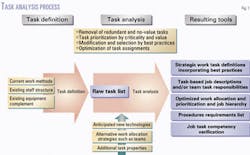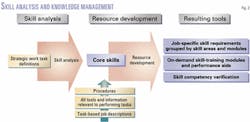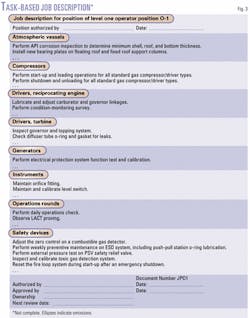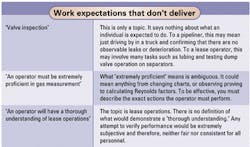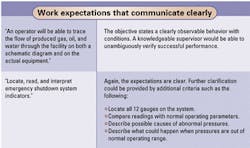Managing Oil and Gas Companies: How strategic personnel development can reduce operations cost
Innovative exploration and production companies are demonstrating that smart investment in personnel development can significantly reduce operations costs and help make their investments in hardware and technology more secure.
Companies such as Shell Offshore Inc., Conoco Inc., Enron Corp., PanCanadian Petroleum Ltd., and others have made major investments in personnel development as part of strategies to in crease operations efficiency.
These strategies appear to be working. Some of the companies are performing the same amount of work, even with staff reductions of 30% or more, and seeing net reductions in operating budgets equal to or exceeding 15%. These personnel development programs can be as encompassing as enterprise-wide, skill-based pay programs or can be focused on more narrow objectives such as process safety management and preventive maintenance.
So why isn't everybody moving more money into personnel development?
Personnel development programs have demonstrated their value, but few companies appear to notice. Even companies that aggressively push the envelope in E&P technology often remain very traditional in the ways they address the development and use of operations personnel.
The primary reason appears to be limited awareness and understanding of personnel development in the executive suite-limited understanding of how programs work, how they generate dollars, how their potential contribution can be estimated, and what are appropriate criteria for measuring program quality.
In addition, emphasis on immediate profitability means that availability of funds for personnel development is generally 180° out of phase with recognition of the need. As a result, even modest programs capable of returning millions over the long run have been less successful in competing for available capital against flashier, more-familiar investments in hardware, software, web technology, and fancier holes in the ground.
What is at stake
The stakes are high, and they go be yond cost savings to the very viability of E&P companies' technology investments and physical assets. All these assets rest in the hands of operations personnel. The diligence and skill of operations oversight and maintenance determine production reliability, reservoir health, and equipment life and efficiency.
Every company has had incidents that underscore this fact. And in many companies, the knowledge that backs the technology is not fully institutionalized and resides mainly in the minds of individual employees.
To some companies, the staffing and operations efficiencies produced by personnel development programs are essential to their competitive position. Other strategic issues also demand consideration of personnel development programs:
- Retaining retiring workers' industry knowledge.
- Creating quicker turnaround and payout on new assets and acquisitions.
- Minimizing the cost and productivity impact of bringing a new generation of operations personnel into the business.
- Implementing new cost-reducing, production-enhancing technologies efficiently.
Personnel development
Many E&P executives equate personnel development with training. In fact, training is only one element of a much larger strategy to reduce costs by more efficiently supplying the skills and manpower needs of the enterprise. A thorough strategy includes several important elements:
- Documenting and prioritizing all tasks needed to carry out a company's goals.
- Optimizing work processes and implementing best practices.
- Assigning work tasks to field personnel more efficiently.
- Capturing and delivering (on an as-needed basis) all information and tools relevant to job performance.
In addition, a comprehensive personnel development strategy may also require:
Defining the skills required for each job position and creating a means to verify competency-and competency must be defined in observable, measurable terms.
Providing training for each job position.
Strategic development
Creating an effective strategic development program boils down to six straightforward steps:
- Explicitly and clearly define all the work employees must perform.
- Prioritize the work, and allocate it in the most efficient manner possible.
- Communicate all work expectations to employees.
- Collect and distribute to employees all relevant information about how to perform the work; then make access to that information as easy, efficient, and timely as possible.
- Verify employee competence to perform assigned work.
- Provide incentives for competence or performance efficiency (optional, as in skill-based pay programs).
Figs. 1 and 2 present a development schema for a strategic personnel development program.
Defining work
The success of any personnel development program depends on unambiguous communication of performance expectations.
Effective personnel development programs are designed around task-specific definitions of work expectations rather than general descriptions of activities. Task definitions describe work in observable, measurable terms (see related article, p.00). Fig. 3 shows an abbreviated portion of a task-based operator job description.
Task definitions break work into discrete components that can be explicitly assigned to an individual or team and whose completion can be observed and confirmed. The result is much greater accountability for preventive maintenance and production monitoring.
In contrast, production monitoring, preventive maintenance, and repairs are generally prioritized and assigned on an ad hoc basis.
Evaluating cost-benefits
By breaking work into individual tasks, managers can also analyze the costs of performing them as well as their value and relative importance. Some of the benefits of this analysis are more-intelligent maintenance strategies and more-efficient work allocation.
When an operating unit has performed a task analysis, work can be prioritized on the basis of a larger perspective, and work can be allocated to most efficiently use operations staff time.
Companies that are successfully reducing operations cost have defined their strategies for prioritization and allocation ahead of time. They have made cost-benefit comparisons of different methods and have institutionalized the optimum path.
By contrast, the activity-based definitions the industry has traditionally used can only tell managers the amount of resources consumed by a given part of the business. Descriptions of activity say nothing about the impact work efficiency or work quality has on the company. Nor do they define the relative benefit or priority of any work.
For example, one company working offshore found it much more efficient to assign to operators certain mechanical and instrument maintenance tasks that previously had been handled by other crafts. With training, operators were able to perform the work and eliminate two additional helicopter trips to each platform. The cost of training was more than offset by the savings in transportation.
Another company found that reacting immediately to every shutin was not as efficient as setting a production threshold for wells, below which they waited until scheduled preventive maintenance runs were made.
Comprehensive task analysis can also facilitate root cause analysis to pinpoint the exact tasks on which performance failures occurred. The aggregate of these analyses can determine the need for training or other intervention. When the costs of failures are tied to specific tasks, companies can quickly see what a lack of knowledge, procedure, or oversight really costs them.
Comprehensive task analysis
Good work allocation decisions are best based on enterprise-wide task analyses that provide a complete model of the work to be performed by all personnel within the business entity. An enterprise-wide analysis enables managers to see what really goes on in the field-exactly what operations payroll is supporting.
Generally, a company's equipment and technology define the majority of operations work, with some additional tasks contributed by administrative procedures. Walking through an equipment list is an effective way to look for most tasks.
New tools
A company can use the raw task list to streamline operations and introduce new technologies. Even a cursory inspection of a set of tasks typically pinpoints unnecessary work and identifies im portant work that has been overlooked. It is not unusual for a company to discover that the majority of tasks are assigned to the job position, "unknown," or to "operator" with no reference to level, tenure, or skill.
By adding measures of importance or criticality, tasks can be prioritized. And with the entire scope of work defined and prioritized, it is easier to develop efficient job assignment strategies. Similarly, tasks will show where the company is using dated or less-than-optimal practices. Companies can easily introduce best practices by including the tasks that represent them.
The immediate product of task analysis is a very clear picture of what the company does and how it does it. It lets companies determine what is the most efficient job hierarchy or reporting structure to allocate and monitor work. It permits very clear job assignments and accountability. When work allocation is based on comprehensive task analyses, work is less likely to be overlooked and more likely to be accomplished in accordance with company procedures.
Task analyses also enable companies to better assess and manage their procedures. Companies can set criteria to determine which tasks must be guided by procedures, then link all relevant procedures to the tasks and identify the holes and procedures that need revision. The task listings can also be used directly to verify job competency.
In summary, conducting task analyses provides:
- A clearer picture of what a company really does.
- The ability to improve work processes.
- Very clear job descriptions and intelligent reporting structures.
- Guidance for developing procedures.
- The ability to confirm job competence.
Performance improvement
Strategic work task definitions also are used to define critical job skills. Skill definitions are communication tools that provide the clearest definition and most efficient assessment of job competence. For example, competency assessments based on performance of tasks are very repetitive: Many steps in a variety of tasks will be identical.
And often memorized recall of task steps is unimportant. The individual pieces of knowledge, analytical skills, and manipulative abilities that are necessary to successfully perform task steps are what are most critical.
Generally, teaching employees skills is much more efficient and effective than rote training of individual tasks. Skill definitions also help training developers create focused, efficient training and produce competency testing.
A strategic performance-management system is driven by the employee and builds in ongoing performance im prove ment. In the most effective programs, performance and personnel development are driven by the individual employee. Job tasks and skill sets are readily available to employees through paper or electronic documents and software. Each employee can access data covering all job task responsibilities for his or her job title or team assignment.
When an individual has identified the specific task at hand, he or she can immediately locate and access any procedures, performance aids, or other tools relevant to that task.
Skill listings are directly linked to self-assessment tools, training modules, and training resources. Employees can see what is required both for their present job and for advancement and can use self-evaluation materials, training modules, and other resources for each skill as needed. Fig.4 illustrates the information flow in a strategic performance management system.
As employees use procedures or go through training or competency verification, they can provide feedback about the accuracy of procedures, effectiveness of training, and fairness of verification to an oversight group. Typically the oversight group represents a vertical cross-section through the organization and may have specific subgroups for individual crafts or technologies.
The oversight group is responsible for regular evergreen review of the program to ensure that any changes in the work environment are reflected in the way work is assigned and performed. They look at any new equipment and technologies to identify new or changed work tasks or new skill requirements. They evaluate new tools and informa -tion for dissemination to the field. And they recommend modifications to job descriptions or work allocation that could improve work efficiency. In systems that provide materials to employees online, any changes to work practices can be implemented almost instantaneously.
Overcoming hurdles
In addition to the need for information about how strategic personnel development programs work, three major hurdles stand in the way of industry acceptance of investment in personnel development:
- Personnel development technology must be seen as an important corporate skill set.
To a large extent, engineering drives operations. Equipment and technology-not psychology or team dynamics-are the primary operations competencies. Naturally, the focus of operations is on doing what it does best, and the net result is that organizations are not exposed to state-of-the-art personnel development technology.
Personnel development usually falls to training departments. And most people who become trainers enter those positions because of extensive technical competence or for other reasons that take them out of field operations. While accurate technical content is essential, personnel development programs re quire many other abilities.
The ability to analyze and optimize work processes, the ability to define an organization's future technology and manpower requirements, and fluency in current curriculum development, training delivery, and competency verification technology are core to personnel development. These skill sets generally are not represented in operations, at executive levels in E&P companies, or in training departments. In addition, training departments are generally given a peripheral role to operations. As a result, they generally do not have a voice in corporate personnel development strategy.
The result is that, because their position limits their effectiveness and their skill sets do not support the required work, operators, trainers, or managers are generally not the best people to design or implement personnel development programs. Firms must recruit manpower development talent and place it high enough in the firm to have impact.
- Programs must be able to demonstrate return on investment to win funding.
Training and development funding (and time) is generally seen as an operations expense and not as an investment that can produce its own return. For example, most operations or asset managers would agree that training is important, but they must be pushed when asked to contribute manpower or money for a specific project.
This prejudice is not entirely without basis. Operations personnel may have seen programs that, frankly, didn't deliver much. To line management, development often seems expensive, of suspect value, and an interference with operations.
For personnel development programs to flourish, they must be able to generate defensible financial justifications for their existence. Task-based work analyses help because they permit clear ROI analyses.
Managers can calculate the cost of performance failures on a task-by-task basis. They can then define corrective steps, estimate their costs, and calculate the anticipated return. This is the kind of information the boardroom needs to initiate personnel development programs.
- Longer-range commitments are needed to supply funding when the need is greatest.
As mentioned earlier, budgets are out of cycle with need. When oil and gas prices are high, people are more concerned with maximizing production than they are with increasing operations efficiency. It's when prices are low that companies become concerned about squeezing every cent out of operations. And that, typically, is exactly when there is no budget for personnel development.
When prices are down, cost-control becomes all-important and effectively eliminates investment in manpower development. Only long-range planning and commitment can end this dead-end impasse. Companies must recognize that personnel development programs are long-range programs that should be viewed with a 3-5 year horizon. And that, in turn, depends on clear financial justification.
A strategic imperative
To understand the importance of personnel development, it's worth looking more closely at requirements that don't show up on the income statement every quarter.
- Retaining the knowledge of retiring workers.
The oil field workforce is aging. Most companies have done the numbers, and unless they act, the knowledge of retiring workers is about to be lost. The cost of rebuilding that knowledge base may cost an individual company tens of millions of dollars. A strategic personnel development program can serve as a true knowledge management system by capturing and disseminating employee knowledge and driving documentation of best work practices. Personnel development programs represent a means to preserve value for a company by documenting employees' collective knowledge.
- The need to create quicker turnaround and payout on new assets and acquisitions.
Speed counts in turning around new acquisitions or bringing new production online. A personnel development strategy produces a franchise-like business template that is logical and easily implemented in new assets. Clear templates for management and personnel deployment can enable companies to absorb and profit from new assets more quickly.
- Minimizing the cost and productivity impact of bringing a new generation of operations personnel into the business.
Collective knowledge must still be transferred to new workers. Training and development must be very focused and cost-effective to accommodate work schedules and satisfy budget constraints. Strategic personnel development programs provide lower-cost development and delivery. Pretesting can exempt skilled personnel from studying in areas in which they are already competent and can help them identify areas in which they need training.
- Efficiently implementing new cost-reducing, production-enhancing technologies.
Deepwater and other new production technologies require skills that can take time to develop. Too often, companies raid their existing organization-or their competitors'-and deplete the workforce in existing operations. Companies need comprehensive plans to define and develop the skills their organizations will need internally. They need to be able to efficiently introduce new technologies and equipment into operations.
And, addressing the bottom line, new personnel development programs represent a means of recapturing lost income through intelligent deployment of a company's most adaptable resource-its field personnel.
Companies need to introduce innovative skill sets to their executive suites to more effectively manage this resource. In return, they can expect enhanced operations efficiencies-and significant savings.
The author
Daniel Follette is president of Daniel Follette Inc. He has over 28 years' experience developing training, safety, and performance programs. He is the principal designer of SkillForge software for work analysis, training devel opment, and delivery. Prior to founding his firm in 1979, he was executive editor at Howell Training and was responsible for the American Petroleum Institute training series-Pilot, Profit, and Plant. Follette received an MA from Michigan State University in1972 and has accomplished additional graduate work at Rice University and the University of Houston.
Creating clear work expectations critical to delivering performance
Whether simply writing a job description or trying to describe training skills, it is crucial to describe observable behavior to create any meaningful definition. Many programs have failed to deliver because the standards they establish for performance are vague or are so broad that they can be satisfied by almost any activity.
It is possible to tell right away if any planned or existing training program is likely to deliver performance by looking at how it defines work expectations: If they don't exist, are very broad, are vague, or simply list the names of equipment or activities, the company is probably not getting much benefit from the money it puts in the program.
The following tables provide examples that demonstrate the difference between meaningful and trivial descriptions of work expectations.
